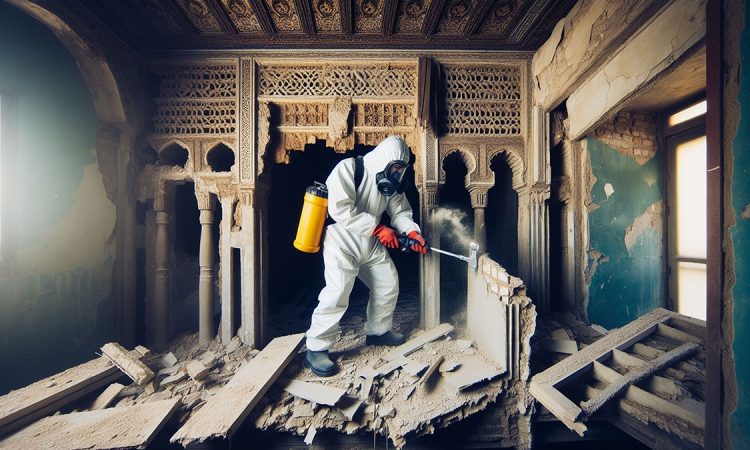
What Is Asbestos?
Asbestos is a group of minerals that were commonly used in building materials before the 1980s. It is known for its heat resistance and strength. However, when these materials are disturbed, tiny fibers can be released into the air, posing serious health risks.
Health Risks Associated With Asbestos
Exposure to asbestos can lead to several severe health issues, including:
- Mesothelioma: A rare cancer affecting the lining of the lungs.
- Asbestosis: A chronic lung disease caused by inhaling asbestos fibers.
- Lung Cancer: Increased risk for those exposed to asbestos over time.
- Pleural Effusion: A buildup of fluid around the lungs.
Common Sources of Asbestos in Homes
Asbestos can be found in various materials in older homes, including:
- Insulation around pipes and boilers
- Textured ceiling tiles
- Vinyl flooring and adhesives
- Roofing shingles
- Siding materials
Understanding these sources is crucial for anyone planning renovations, as disturbing these materials can release harmful fibers into the air.
Identifying Asbestos in Older Homes
Signs of Asbestos-Containing Materials
Identifying asbestos in older homes can be challenging. Here are some signs that materials may contain asbestos:
- Age of the Home: Homes built before the 1980s are more likely to have asbestos.
- Material Type: Look for materials like ceiling tiles, floor tiles, and insulation that may contain asbestos.
- Condition: If materials are damaged or crumbling, they may release harmful fibers.
Common Areas Where Asbestos Is Found
Asbestos can be found in various parts of older homes. Common locations include:
- Insulation: Often found around pipes and in attics.
- Flooring: Vinyl tiles and the adhesive used can contain asbestos.
- Ceilings: Textured ceiling tiles and popcorn ceilings may have asbestos.
- Roofing: Shingles and roofing materials can also contain asbestos.
How to Conduct an Asbestos Inspection
To ensure safety, follow these steps for an asbestos inspection:
- Hire a Professional: Always consult a certified asbestos inspector for accurate results.
- Visual Inspection: The inspector will look for signs of asbestos in various materials.
- Sample Testing: If necessary, samples will be taken and sent to a lab for analysis.
- Report Findings: The inspector will provide a report detailing any asbestos found and recommend next steps.
Safety Precautions for Veterans During Renovations
When veterans undertake home renovations, it is crucial to prioritize safety, especially regarding asbestos exposure. Here are essential precautions to consider:
Personal Protective Equipment (PPE)
- Wear a mask: Use a respirator that is rated for asbestos to protect your lungs.
- Use gloves: Ensure that gloves are durable and can prevent any contact with asbestos fibers.
- Protective clothing: Wear disposable coveralls to avoid bringing asbestos fibers home on your clothes.
Safe Work Practices
- Do not disturb: Avoid disturbing materials that may contain asbestos unless necessary.
- Seal off areas: Use plastic sheeting to seal off work areas to prevent the spread of asbestos fibers.
- Wet methods: If you must work with asbestos, keep materials damp to minimize dust.
Emergency Procedures for Asbestos Exposure
- Leave the area immediately: If you suspect exposure, exit the area right away.
- Seek medical attention: Contact a healthcare provider if you experience symptoms like coughing or shortness of breath.
- Report the incident: Inform local health authorities about potential asbestos exposure to ensure proper follow-up.
By following these safety measures, veterans can significantly reduce the risk of asbestos-related illnesses, such as mesothelioma, which is a serious concern for those with a history of exposure. It is essential to stay informed and take proactive steps to protect health during renovations.
Hiring Professionals for Asbestos Abatement
Choosing a Qualified Asbestos Abatement Company
When dealing with asbestos, it is crucial to hire a qualified abatement company. Here are some steps to follow:
- Check Credentials: Ensure the company is licensed and certified by the appropriate state agency.
- Read Reviews: Look for customer feedback and check for any complaints with the Better Business Bureau.
- Ask About Experience: Inquire how long the company has been in business and their experience with similar projects.
What to Expect During the Abatement Process
The abatement process can vary, but generally includes:
- Initial Inspection: A professional will assess the area to identify asbestos-containing materials.
- Containment: The area will be sealed off to prevent asbestos fibers from spreading.
- Removal or Encapsulation: Asbestos will either be removed or safely sealed to prevent exposure.
- Final Inspection: After the work is done, a follow-up inspection ensures the area is safe.
Cost Considerations for Asbestos Removal
The cost of asbestos abatement can vary widely based on several factors:
- Extent of Asbestos: More extensive contamination will increase costs.
- Location: Costs may differ based on your region.
- Company Rates: Different companies may charge varying rates for their services.
It is essential for veterans to understand that asbestos used in the military poses significant risks, and hiring professionals is a critical step in ensuring safety during home renovations. Taking these precautions can help protect health and well-being.
Legal Rights and Benefits for Veterans Exposed to Asbestos
Understanding VA Benefits
Asbestos exposure can lead to mesothelioma for Navy veterans, Army, Marines, and Air Force vets as well. Veterans who have been exposed to asbestos during their service may be eligible for various benefits through the Department of Veterans Affairs (VA). These benefits can include:
- Health Care: Access to medical treatment for asbestos-related diseases.
- Disability Compensation: Financial support for veterans diagnosed with conditions linked to asbestos exposure.
- Vocational Rehabilitation: Assistance in finding suitable employment if health issues affect work capabilities.
Filing Claims for Asbestos-Related Illnesses
To receive benefits, veterans must file a claim with the VA. The process generally involves:
- Gathering Medical Evidence: Collect documentation of the asbestos-related illness.
- Submitting the Claim: Complete the necessary forms and submit them to the VA.
- Follow-Up: Stay in contact with the VA for updates on the claim status.
Resources for Veterans and Their Families
Veterans and their families can access various resources to help navigate the complexities of asbestos exposure and related benefits. Some useful resources include:
- Veterans Service Organizations: Groups that provide assistance in filing claims and understanding benefits.
- Legal Aid: Services that can help veterans seek compensation for asbestos-related health issues.
- Support Groups: Communities where veterans can share experiences and receive emotional support.
Veterans exposed to asbestos during their service have rights and benefits available to them. Understanding these options is crucial for ensuring they receive the support they need.
Long-Term Health Monitoring After Asbestos Exposure
Symptoms to Watch For
After being exposed to asbestos, it is crucial to monitor for any symptoms that may arise. Common signs to be aware of include:
- Difficulty breathing
- Persistent cough
- Chest pain
- Unexplained weight loss
These symptoms can indicate serious health issues, including lung diseases related to asbestos exposure.
Regular Health Check-Ups
Veterans who have been exposed to asbestos should schedule regular health check-ups with their healthcare provider. These check-ups can help in early detection of any potential health problems. It is advisable to:
- Discuss your asbestos exposure history with your doctor.
- Follow a monitoring plan that may include imaging tests like X-rays or CT scans.
- Stay informed about any new symptoms that may develop over time.
Importance of Medical History Documentation
Keeping a detailed record of medical history is essential for veterans exposed to asbestos. This documentation should include:
- Details of exposure (when and where it occurred)
- Any symptoms experienced over time
- Medical treatments received
This information can be vital for healthcare providers in managing health risks and for veterans seeking benefits related to asbestos exposure. Being proactive about health can lead to better outcomes, especially in detecting conditions like mesothelioma, which is linked to asbestos exposure.
Veterans are encouraged to take these steps seriously to ensure their long-term health and well-being.




